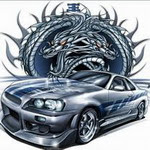

A TDI from Audi is more than just another diesel - it is, in fact, a dynamic power unit and a rich source of driving pleasure. At the 27th annual Lake Wörther Tour being held in the Austria province of Carinthia from May 21-25, Audi is demonstrating the potential of TDI technology with a very special concept study: the Audi A3 TDI clubsport quattro is powered by an engine delivering a whole 165 kW (224 hp) from its displacement of two liters. And with a torque of 450 Nm (331.90 lb-ft), it endows the premium compact model with the pulling power of a sports car.
The Audi A3 TDI clubsport quattro qualifies as an uncompromising sports machine in all other technical respects too. A six-speed transmission channels the engine's power to the quattro all-wheel drive. 20-inch wheels keep the drive force glued to the road; behind the wheels at the front can be found brake disks made from carbon-fiber-reinforced ceramic. Using the Audi drive select driving dynamics system the driver is able to adjust the throttle response and exhaust sound characteristics, the steering's power assistance, the ESP control and the damper characteristics as desired.
The dynamic image presented by the scintillating A3 study is rounded off by spectacular body styling and a high-class, sporty interior. Parts such as bolt-on wheel arch extensions and a large rear spoiler lend lasting impact to the exterior's looks; the interior is dominated by the racing bucket seats in the front and the open aluminum gear lever gate.
The drive train
The high-performance TDI under the bonnet of the Audi A3 TDI clubsport quattro is like nothing that has gone before it. From its displacement of just 1,968 cc, it summons up an output of 165 kW (224 hp). Torque - the true measure of effortless motoring ability - peaks at an exhilarating 450 Nm (331.90 lb-ft), which is on tap from just 1,750 rpm; in other words, the very bottom of the rev range. As for in-gear flexibility, the diesel model leaves its gasoline-powered rivals standing.
The mighty TDI bestows the Audi A3 TDI clubsport quattro - which tips the scales at just 1,475 kilograms (3251.82 lb) - with pulling power befitting of a sports car. The sprint from 0 to 100 km/h (62.14 mph) is over in a fleeting 6.6 seconds and the speedometer needle keeps rising all the way to 240 km/h (149.13 mph).
The four-valve sports engine is smart too; it responds spontaneously to the throttle and pampers the occupants with the low-vibration running of its mechanics. On an acoustic level, however, it proudly proclaims its abilities for all to hear: the exhaust system is a new development, with controllable resonance chambers on both tailpipes to amplify the rich, sonorous sound.
The engineers took as a basis the undersquare engine (bore x stroke = 81.0 x 95.5 millimeters) with an output of either 103 kW (140 hp) or 125 kW (170 hp), depending on the configuration, and added to it an optimized turbocharger. The advanced design of its blades allows it to supply more air; as in the series-production version, the variable geometry of the turbine's blades ensures spontaneous response.
The 2.0 TDI, which is managed by one of the most sophisticated control units currently available on the market, is brimming with high tech. Fuel injection is handled by a common-rail system with piezoelectric injectors and eight-hole nozzles. The high-precision metering of as many as five injections of fuel per power stroke has the effect of audibly reducing the noise level. The system operates at a pressure of 1,800 bar - this results in extremely fine atomization of the fuel which, together with the revised piston geometry, makes the combustion process a highly efficient one.
The engine's intake manifold houses swirl flaps that generate a tumbling action in the inflowing air; electric motors regulate the flaps' position so that this tumbling motion is always perfectly suited to the current load and engine speed. Two balancer shafts in the engine reduce the degree of vibration in the crank drive. The drive unit for the belt that propels the two camshafts has also been reworked with a view to improving the engine's acoustics.
The engine: low on emissions, high on efficiency
In its high-performance 165 kW (224 hp) version, the 2.0 TDI unit is still able to make use of a high proportion of recirculated and sharply cooled exhaust gas to achieve cooler combustion with lower oxygen levels - this brings about a substantial reduction in untreated nitrogen oxide emissions. The four-cylinder power unit already complies with the limits of the Euro 5 emissions standard, which is not due to come into force until September 2010 and whose foremost aim is to cut NOx emissions.
The ultra-efficient two-liter engine attains a power-to-displacement ratio of 83.8 kW (113.8 hp) per liter, and torque-to-displacement ratio of 228.7 Nm (168.68 lb-ft) per liter - figures which comparable gasoline engines are simply unable to match.
The Audi A3 TDI clubsport quattro has been designed strictly in accordance with the principle of maximum efficiency. Power is transferred by a compact, transverse-mounted six-speed transmission whose casing is made from lightweight magnesium. The short-throw gear lever can be moved swiftly and precisely through a classic open gate made of aluminum. The transmission ratios have been adjusted and the components reinforced to make allowance for the TDI engine's extremely high performance.
The engine's power is transferred to the road with virtually zero losses thanks to the quattro all-wheel drive. The system's key component is a multi-plate clutch which is positioned at the rear, thereby further optimizing the weight distribution. Under normal driving conditions, the electronically controlled and hydraulically operated clutch directs the engine's drive power to the front wheels; whenever necessary, however, an infinitely adjustable proportion of the propulsive force can be diverted rearwards.
When altering the power split, the plates inside the clutch are subjected to high oil pressure, pushing them together - a procedure which is completed in a matter of milliseconds thanks to a newly designed pressure reservoir for the pump. The quattro drive constitutes the perfect power transmission system for the mighty two-door model, significantly enhancing traction, handling characteristics, stability and straight-line running, whatever the weather.
The chassis
The Audi A3 TDI clubsport quattro comes equipped with a sports suspension that is more than capable of handling the formidable power. The front suspension - a classic McPherson layout - is pivoted on a light, high-strength aluminum subframe. A rack-and-pinion steering system with a direct ratio produces a sensation of close contact with the road. Power assistance is generated by an electromechanical drive unit for high efficiency, and its level decreases as the speed increases.
The rear suspension comprises four links per wheel which fulfill all manner of tasks. The trailing links absorb the propulsive and braking forces. As an aid to ride comfort, their configuration is relatively soft. The connections to the three transverse links, on the other hand, are rigid in order to direct transverse forces into the body with absolute precision. In this instance, the coil springs and shock absorbers are also kept separate from one another. The set-up is decidedly firm, while the body has been lowered by 36 millimeters (1.42 inches) compared to the standard production version.
The Audi A3 TDI clubsport quattro rides on impressive ten-spoke wheels measuring 9 J x 20, which are in turn shod with size 265/30 ZR 20 tires.
Whereas the brakes at the rear wheels were borrowed from the series-production A3, their counterparts on the front would not be out of place on a supercar: six-piston calipers exert a vice-like grip on brake discs measuring 356 millimeters (14.02 inches) in diameter. The discs themselves are made of a material which has been of tremendous value to the aerospace industry, consisting of high-strength carbon fibers embedded in hard silicon carbide.
They have a lightweight construction, can withstand extreme levels of strain, are corrosion-free and have a service life in the region of 300,000 km (approx. 186,400 miles).
TDI engines - the superior drive force
Power, refinement and efficiency - ever since they first made their debut in 1989, the TDI engines from Audi have been synonymous with a sophisticated and smart form of sportiness, blazing a trail for the rest of the motor industry to follow. The triumphant advance that the diesel-engined Audi R10 TDI racing car has been enjoying for two years now on race tracks around the world has delivered a powerful demonstration of its potential.
The R10 TDI has been causing a sensation since spring 2006, with its twelve-cylinder diesel powerplant ushering in a new era in the world of motor racing. The 5.5-litre TDI develops in excess of 1,100 Nm (881.32 lb-ft) - a torque figure that positively eclipses its gasoline-powered competitors. Its output of 650 hp translates into a top speed of around 330 km/h (205.05 mph).
One of the fortes of the R10 TDI is its low fuel consumption. And fewer fuel stops means a higher average speed - the car's high efficiency was one of the key factors in its two successive victories at the Le Mans 24 Hours. Frank Biela (Germany), Emanuele Pirro (Italy) and Marco Werner (Germany) won in 2006 and 2007 in emphatic style. It is a similar story in the American Le Mans Series, where the diesel race car bearing the four Audi rings has racked up a string of successes, easily securing the constructors' title in the large LMP 1 category in both years.
For the first time ever, superior TDI power from the race track can now be experienced in a series-production sports car - both the Audi TT Coupé 2.0 TDI quattro and the Audi TT Roadster 2.0 TDI quattro feature a diesel engine. The two-liter four-cylinder unit delivers dynamic thrust, with a power output of 125 kW (170 hp) and 350 Nm (258.15 lb-ft) of torque. Despite this, the TDI engine in the Coupé burns just 5.3 liters of fuel per 100 km (44.38 mpg) on average - a benchmark value in the sports car segment.
Also on show at the Lake Wörther Tour is the Audi R8 TDI Le Mans, whose drive train technology is closely related to that of the R 10 TDI. The high-performance sports car is driven by a six-liter V12, whose 368 kW (500 hp) of output and 1,000 Nm (737.56 lb-ft) of torque propel the world's most powerful series-production TDI model to a top speed far in excess of 300 km/h (186.41 mph).








No comments:
Post a Comment